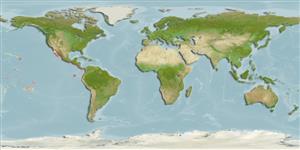分類 / Names
俗名 | 同種異名 | Catalog of Fishes(屬, 種) | ITIS | CoL | WoRMS | Cloffa
Teleostei >
Eupercaria/misc (Various families in series Eupercaria)
鱸形目 (Various families in series Eupercaria) >
Labridae (Wrasses)
隆頭魚科 (Wrasses) > Corinae
Etymology: Halichoeres: Greek, als, alis = salt + Greek, choiros = pig (Ref. 45335).
More on author: Günther.
Environment: milieu / climate zone / depth range / distribution range
生態學
海洋 礁區魚類; 深度上下限 0 - 10 m (Ref. 9311). 熱帶; 32°N -
Eastern Pacific: Bahía Magdalena, Mexico south to Peru, including the Galapagos Islands.
東太平洋: Bahia Magdalena, 墨西哥南至祕魯, 包括加拉巴哥群島。
大小 / 重量 / 年齡
Maturity: Lm ? range ? - ? cm
Max length : 25.4 cm TL 雄魚/尚未辨別雌雄; (Ref. 5592); common length : 15.0 cm TL 雄魚/尚未辨別雌雄; (Ref. 55763)
Common in shallow waters, especially where brown algae exists (Ref. 9311). Diet consists of crustaceans, sea urchins, mollusks, and brittle stars. It loses its blue-green coloration, turns dull brown in captivity.
常見於淺水域, 尤其褐色藻類存在的地方.(參考文獻 9311) 食物由甲殼動物,海膽,軟體動物與海星組成。 它失去它的藍綠色顏色, 變暗褐色的在繁殖場。
Life cycle and mating behavior
Maturities | 繁殖 | Spawnings | Egg(s) | Fecundities | 仔魚
Distinct pairing during breeding (Ref. 205).東太平洋: Bahia Magdalena, 墨西哥南至祕魯, 包括加拉巴哥群島。
Thomson, D.A., 1987. Reef fishes of the Sea of Cortez. The rocky-shore fishes of the Gulf of California. The University of Arizona Press, Tucson. 302 p. (Ref. 5592)
人類使用
工具
特別的報告
下載 XML
網路資源
Estimates based on models
Preferred temperature (Ref.
123201): 22.4 - 29.1, mean 26.8 °C (based on 245 cells).
Phylogenetic diversity index (Ref.
82804): PD
50 = 0.5000 [Uniqueness, from 0.5 = low to 2.0 = high].
Bayesian length-weight: a=0.00955 (0.00451 - 0.02020), b=3.09 (2.92 - 3.26), in cm total length, based on LWR estimates for this Genus-body shape (Ref.
93245).
營養階層 (Ref.
69278): 3.5 ±0.43 se; based on food items.
回復力 (Ref.
120179): 中等的, 族群倍增時間最少 1.4 - 4.4年 (Preliminary K or Fecundity.).
Fishing Vulnerability (Ref.
59153): Low vulnerability (15 of 100).
Nutrients (Ref.
124155): Calcium = 64.9 [38.4, 108.0] mg/100g; Iron = 0.625 [0.358, 1.166] mg/100g; Protein = 18.6 [15.8, 20.9] %; Omega3 = 0.128 [0.081, 0.199] g/100g; Selenium = 20.2 [12.2, 37.0] μg/100g; VitaminA = 126 [38, 457] μg/100g; Zinc = 1.53 [1.07, 2.41] mg/100g (wet weight);
